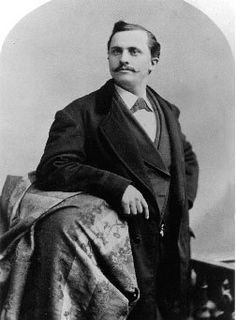

Imagine a man who gives over 3,000 acres of land to his adopted hometown for a park, and then donates a fortune to build a popular observatory/planetarium/hall of science and a large open-air theater.
Imagine a man who enrages many of his peers with long years of insufferable pomposity and then shoots his well-regarded high-society wife in a paranoid delusion that she is in league with the Pope to poison him and steal his money.
Imagine if they were the same man.
You've just imagined one of the most unimaginable characters in the history of Los Angeles, Col. Griffith J. Griffith.
Famous for Giving Griffith Park to the City, Col. Griffith, who died on July 6, 1919, is mostly remembered as donor of 3015 acres that became the core of Griffith Park, and for donating money to build the park's Greek Theatre and Griffith Observatory. But the "colonel" was a complicated man. He had towering virtues and cavernous faults. Along with other big property holders, he made enormous profits from rampant, feverish land speculation that peaked in 1886-87. And, oh yes, he married into money as well. Christina Mesmer wasn't just rich, she was also dignified and respected. They remained married for 16 years. Then in 1903 things went tragically haywire. Although the colonel was richer and more powerful than ever, he was also terribly nervous and edgy, his wife later testified. He compulsively bit his nails, his manicurist said. And he was a sneak drinker, his lawyer said, privately putting away two quarts of whiskey a day while publicly aligning himself with the city's strong temperance movement.
In August the Griffiths went to the Arcadia Hotel in Santa Monica. Christina Griffith hoped a month in the Presidential Suite overlooking the palisades would help her husband unwind. But the colonel's strange behavior intensified. Waitresses said he switched his food and drink with his wife's. You never know if someone's trying to poison you, he told them. They chalked it up to a strange sense of humor.
But the last day of the Griffiths' vacation was about as unfunny as things get. Christina Griffith was addressing a few last postcards and beginning to gather her things. Her husband entered the room with a prayer book in one hand and a revolver in the other. Unfortunately, he handed her the prayer book.
She was on her knees when the colonel aimed and fired. Christina Griffith jerked her head at the last minute. That saved her life. She hurled herself out a window, landed on an awning below, and crawled to safety through another window. One author who attended Col. Griffith's trial called Christina Griffith "the society wife who wouldn't die."
Colonel Brought to JusticeThe shooting left Christina Griffith disfigured and blind in one eye. Some observers say the colonel was lucky he wasn't lynched. His trial was spectacular and ghastly. Special prosecutors, led by an ex-governor, were called in. The defense was based around a novel idea: alcoholic insanity. Earl Rogers, the colonel's attorney, argued that heavy and steady consumption of alcohol had transformed religious friction in the Griffiths' marriage--he was Protestant, she was Catholic, and they were both devout--into weird murderous delusions. The defense worked. Col. Griffith was sentenced to two years in prison, with the stipulation that he be treated for his alcoholic insanity.
Whatever it was that snapped in the colonel in 1903 apparently snapped back while he was in prison. From his cell at San Quentin, he asked that he not be given any special treatment. He passed up an opportunity to work in the prison library; instead, he made burlap sacks in the jute mill alongside humbler prisoners. He refused parole as well. One of his few remaining friends, a judge, said the colonel wanted to pay his debt to society as fully as possible.
Colonel Rebuilds His LifeWhen he got out of prison, the colonel had little--other than the park land he had donated to the city in 1896--to tie him to Los Angeles. Most people around town still hated him and most of the others thought he was crazy. He was divorced. His only child was independent. And he was still rich.
But he returned to Los Angeles and stayed for the remaining 13 years of his life. Sources say he was quieter and less pompous. He lectured on prison reform, advocating rehabilitation over punishment. And he persistently worked at improving his park.
In 1912 he offered the city $100,000 to build a popular observatory atop Mt. Hollywood (Formerly Mt. Griffith, it had been renamed while he was in prison.). In his letter to the mayor and city council, the colonel waxed expansively about opening up the heavens to the common people, inspiring, educating and uplifting them. "Ambition," he wrote, "must have broad spaces and mighty distances."
If someone else had made the offer, the city might have jumped at it. But, as things stood, the city council jumped the other way, flatly refusing the money. Wrote one prominent citizen in a letter published on the front page of a local newspaper:
On behalf of the rising generation of girls and boys we protest against the acceptance of this bribe . . . This community is neither so poor nor so lost to sense of public decency that it can afford to accept this money.
The colonel, however, pressed on. In 1913 he offered $50,000 to build a Greek Theater. That project also ground to a standstill. At one point the Park Commission brought suit to force the colonel to stop preparations for construction. The colonel responded by setting up a trust fund to provide money for building the two facilities he had promised after he was gone.
Millions have enjoyed Griffith Park during the nearly 100 years since Col. Griffith donated it to the city. The Greek Theatre has stood for 65 years, the Observatory for 60.

















